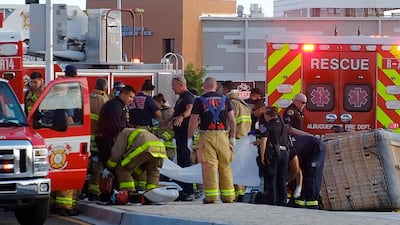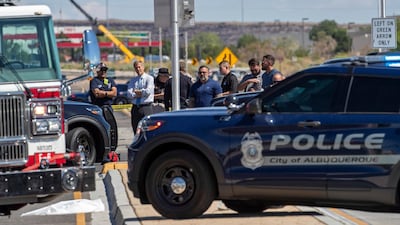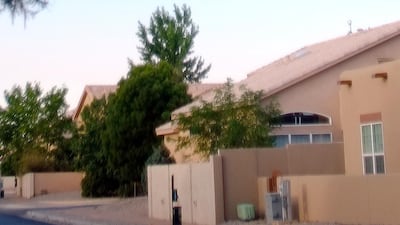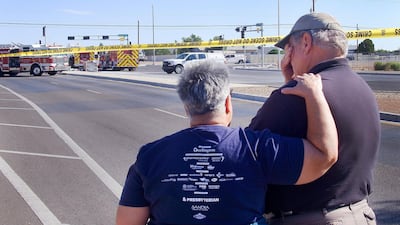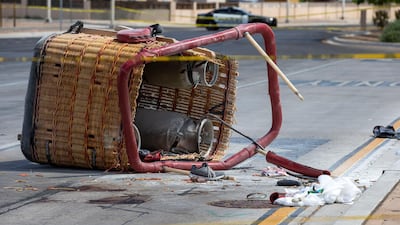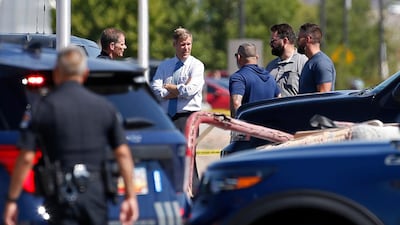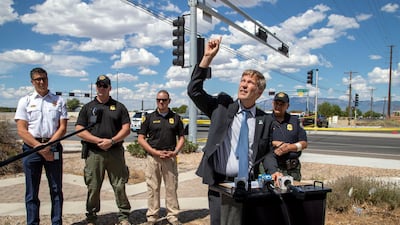A hot air balloon crashed in a neighbourhood of Albuquerque, New Mexico, on Saturday, killing five people after apparently being blown into power lines by the wind and catching fire, police said.
The pilot and three passengers were pronounced dead at the scene, police said. The fourth passenger was taken to an Albuquerque hospital where he died of his injuries.
The basket crashed into a street corner in the city's West Side neighbourhood, about 10 kilometres west of Albuquerque International Sunport Airport, according to a report from the Federal Aviation Administration.
The balloon separated from the basket after it crashed, and landed elsewhere, police said.
The ages of the victims are between 40 and 60, police said, but no names were released. No one on the ground was injured.
Witnesses told police the balloon hit a power line shortly after 7am local time.
"We know from experience here in Albuquerque that sometimes winds kick up or things happen that make it difficult for balloons to navigate," Albuquerque Police spokesman Gilbert Gallegos told reporters.
The intersection where the balloon crashed was still cordoned off late Saturday afternoon. The multicoloured balloon had skirted the top of the power lines, sending at least one dangling and knocking out power to more than 13,000 homes, said police spokesman Gilbert Gallegos.
The gondola fell about 30 metres and crashed in the street's median, catching fire, the FAA said. Bystanders frantically called out for a fire extinguisher to put out the flames and prayed aloud, video posted online showed.
The envelope of the balloon floated away, eventually landing on a residential rooftop, Mr Gallegos said. The FAA did not immediately have registration details for the balloon but identified it as a Cameron 0-120.
Authorities haven’t determined what caused the crash. The National Transportation Safety Board sent two investigators to the scene on Saturday who will look into the pilot, the balloon itself and the operating environment, said spokesman Peter Knudson. A preliminary report typically is available in a couple of weeks.
Mr Gallegos said hot air balloons can be difficult to manage, particularly when the wind kicks up.
“Our balloonists tend to be very much experts at navigating, but sometimes we have these types of tragic accidents,” he said.
Albuquerque residents are treated to colourful displays of balloons floating over homes and along the Rio Grande throughout the year. While accidents are not common, they happen.
“This is a tragedy that is uniquely felt and hits uniquely hard at home here in Albuquerque and in the ballooning community,” said Albuquerque Mayor Tim Keller.
Since 2008, there have been 12 fatal hot air ballooning accidents in the United States, according to an NTSB database. Two of those happened in Rio Rancho just outside Albuquerque, including one in January where a passenger who was ejected from the gondola after a hard landing died from his injuries.
In 2016, in neighbouring Texas, a hot air balloon hit high-tension power lines before crashing into a pasture in the central part of the state. All 16 people on board died. Federal authorities said at the time it was the worst such disaster in US history.
Isle of Dogs
Director: Wes Anderson
Starring: Bryan Cranston, Liev Schreiber, Ed Norton, Greta Gerwig, Bill Murray, Jeff Goldblum, Scarlett Johansson
Three stars
Brief scores:
Everton 2
Walcott 21', Sigurdsson 51'
Tottenham 6
Son 27', 61', Alli 35', Kane 42', 74', Eriksen 48'
Man of the Match: Son Heung-min (Tottenham Hotspur)
if you go
The flights
Emirates flies to Delhi with fares starting from around Dh760 return, while Etihad fares cost about Dh783 return. From Delhi, there are connecting flights to Lucknow.
Where to stay
It is advisable to stay in Lucknow and make a day trip to Kannauj. A stay at the Lebua Lucknow hotel, a traditional Lucknowi mansion, is recommended. Prices start from Dh300 per night (excluding taxes).
The biog
Siblings: five brothers and one sister
Education: Bachelors in Political Science at the University of Minnesota
Interests: Swimming, tennis and the gym
Favourite place: UAE
Favourite packet food on the trip: pasta primavera
What he did to pass the time during the trip: listen to audio books
Dengue%20fever%20symptoms
%3Cp%3EHigh%20fever%20(40%C2%B0C%2F104%C2%B0F)%3Cbr%3ESevere%20headache%3Cbr%3EPain%20behind%20the%20eyes%3Cbr%3EMuscle%20and%20joint%20pains%3Cbr%3ENausea%3Cbr%3EVomiting%3Cbr%3ESwollen%20glands%3Cbr%3ERash%26nbsp%3B%3C%2Fp%3E%0A
UAE SQUAD
Goalkeepers: Ali Khaseif, Fahad Al Dhanhani, Mohammed Al Shamsi, Adel Al Hosani
Defenders: Bandar Al Ahbabi, Shaheen Abdulrahman, Walid Abbas, Mahmoud Khamis, Mohammed Barghash, Khalifa Al Hammadi, Hassan Al Mahrami, Yousef Jaber, Salem Rashid, Mohammed Al Attas, Alhassan Saleh
Midfielders: Ali Salmeen, Abdullah Ramadan, Abdullah Al Naqbi, Majed Hassan, Yahya Nader, Ahmed Barman, Abdullah Hamad, Khalfan Mubarak, Khalil Al Hammadi, Tahnoun Al Zaabi, Harib Abdallah, Mohammed Jumah, Yahya Al Ghassani
Forwards: Fabio De Lima, Caio Canedo, Ali Saleh, Ali Mabkhout, Sebastian Tagliabue, Zayed Al Ameri
Jigra
Starring: Alia Bhatt, Vedang Raina, Manoj Pahwa, Harsh Singh
T20 World Cup Qualifier, Muscat
UAE FIXTURES
Friday February 18: v Ireland
Saturday February 19: v Germany
Monday February 21: v Philippines
Tuesday February 22: semi-finals
Thursday February 24: final
MOUNTAINHEAD REVIEW
Starring: Ramy Youssef, Steve Carell, Jason Schwartzman
Director: Jesse Armstrong
Rating: 3.5/5
NEW%20PRICING%20SCHEME%20FOR%20APPLE%20MUSIC%2C%20TV%2B%20AND%20ONE
%3Cp%3E%3Cstrong%3EApple%20Music%3Cbr%3EMonthly%20individual%3A%20%3C%2Fstrong%3E%2410.99%20(from%20%249.99)%3Cstrong%3E%3Cbr%3EMonthly%20family%3A%20%3C%2Fstrong%3E%2416.99%20(from%20%2414.99)%3Cstrong%3E%3Cbr%3EIndividual%20annual%3A%20%3C%2Fstrong%3E%24109%20(from%20%2499)%3C%2Fp%3E%0A%3Cp%3E%3Cstrong%3EApple%20TV%2B%3Cbr%3EMonthly%3A%20%3C%2Fstrong%3E%246.99%20(from%20%244.99)%3Cstrong%3E%3Cbr%3EAnnual%3A%20%3C%2Fstrong%3E%2469%20(from%20%2449.99)%3C%2Fp%3E%0A%3Cp%3E%3Cstrong%3EApple%20One%3Cbr%3EMonthly%20individual%3A%20%3C%2Fstrong%3E%2416.95%20(from%20%2414.95)%3Cstrong%3E%3Cbr%3EMonthly%20family%3A%20%3C%2Fstrong%3E%2422.95%20(from%20%2419.95)%3Cstrong%3E%3Cbr%3EMonthly%20premier%3A%20%3C%2Fstrong%3E%2432.95%20(from%20%2429.95)%3C%2Fp%3E%0A
Indoor cricket World Cup:
Insportz, Dubai, September 16-23
UAE fixtures:
Men
Saturday, September 16 – 1.45pm, v New Zealand
Sunday, September 17 – 10.30am, v Australia; 3.45pm, v South Africa
Monday, September 18 – 2pm, v England; 7.15pm, v India
Tuesday, September 19 – 12.15pm, v Singapore; 5.30pm, v Sri Lanka
Thursday, September 21 – 2pm v Malaysia
Friday, September 22 – 3.30pm, semi-final
Saturday, September 23 – 3pm, grand final
Women
Saturday, September 16 – 5.15pm, v Australia
Sunday, September 17 – 2pm, v South Africa; 7.15pm, v New Zealand
Monday, September 18 – 5.30pm, v England
Tuesday, September 19 – 10.30am, v New Zealand; 3.45pm, v South Africa
Thursday, September 21 – 12.15pm, v Australia
Friday, September 22 – 1.30pm, semi-final
Saturday, September 23 – 1pm, grand final
PROFILE OF HALAN
Started: November 2017
Founders: Mounir Nakhla, Ahmed Mohsen and Mohamed Aboulnaga
Based: Cairo, Egypt
Sector: transport and logistics
Size: 150 employees
Investment: approximately $8 million
Investors include: Singapore’s Battery Road Digital Holdings, Egypt’s Algebra Ventures, Uber co-founder and former CTO Oscar Salazar
Scores in brief:
Boost Defenders 205-5 in 20 overs
(Colin Ingram 84 not out, Cameron Delport 36, William Somerville 2-28)
bt Auckland Aces 170 for 5 in 20 overs
(Rob O’Donnell 67 not out, Kyle Abbott 3-21).
Lexus LX700h specs
Engine: 3.4-litre twin-turbo V6 plus supplementary electric motor
Power: 464hp at 5,200rpm
Torque: 790Nm from 2,000-3,600rpm
Transmission: 10-speed auto
Fuel consumption: 11.7L/100km
On sale: Now
Price: From Dh590,000
%20Ramez%20Gab%20Min%20El%20Akher
%3Cp%3E%3Cstrong%3ECreator%3A%3C%2Fstrong%3E%20Ramez%20Galal%3C%2Fp%3E%0A%3Cp%3E%3Cstrong%3EStarring%3A%3C%2Fstrong%3E%20Ramez%20Galal%3C%2Fp%3E%0A%3Cp%3E%3Cstrong%3EStreaming%20on%3A%20%3C%2Fstrong%3EMBC%20Shahid%3C%2Fp%3E%0A%3Cp%3E%3Cstrong%3ERating%3A%20%3C%2Fstrong%3E2.5%2F5%3C%2Fp%3E%0A
The specs
Engine: 3.9-litre twin-turbo V8
Transmission: seven-speed
Power: 720hp
Torque: 770Nm
Price: Dh1,100,000
On sale: now
THE SPECS
Touareg Highline
Engine: 3.0-litre, V6
Transmission: 8-speed automatic
Power: 340hp
Torque: 450Nm
Price: Dh239,312
Key figures in the life of the fort
Sheikh Dhiyab bin Isa (ruled 1761-1793) Built Qasr Al Hosn as a watchtower to guard over the only freshwater well on Abu Dhabi island.
Sheikh Shakhbut bin Dhiyab (ruled 1793-1816) Expanded the tower into a small fort and transferred his ruling place of residence from Liwa Oasis to the fort on the island.
Sheikh Tahnoon bin Shakhbut (ruled 1818-1833) Expanded Qasr Al Hosn further as Abu Dhabi grew from a small village of palm huts to a town of more than 5,000 inhabitants.
Sheikh Khalifa bin Shakhbut (ruled 1833-1845) Repaired and fortified the fort.
Sheikh Saeed bin Tahnoon (ruled 1845-1855) Turned Qasr Al Hosn into a strong two-storied structure.
Sheikh Zayed bin Khalifa (ruled 1855-1909) Expanded Qasr Al Hosn further to reflect the emirate's increasing prominence.
Sheikh Shakhbut bin Sultan (ruled 1928-1966) Renovated and enlarged Qasr Al Hosn, adding a decorative arch and two new villas.
Sheikh Zayed bin Sultan (ruled 1966-2004) Moved the royal residence to Al Manhal palace and kept his diwan at Qasr Al Hosn.
Sources: Jayanti Maitra, www.adach.ae
How it works
1) The liquid nanoclay is a mixture of water and clay that aims to convert desert land to fertile ground
2) Instead of water draining straight through the sand, it apparently helps the soil retain water
3) One application is said to last five years
4) The cost of treatment per hectare (2.4 acres) of desert varies from $7,000 to $10,000 per hectare
The Gandhi Murder
- 71 - Years since the death of MK Gandhi, also christened India's Father of the Nation
- 34 - Nationalities featured in the film The Gandhi Murder
- 7 - million dollars, the film's budget
T10 Cricket League
Sharjah Cricket Stadium
December 14- 17
6pm, Opening ceremony, followed by:
Bengal Tigers v Kerala Kings
Maratha Arabians v Pakhtoons
Tickets available online at q-tickets.com/t10
Ten tax points to be aware of in 2026
1. Domestic VAT refund amendments: request your refund within five years
If a business does not apply for the refund on time, they lose their credit.
2. E-invoicing in the UAE
Businesses should continue preparing for the implementation of e-invoicing in the UAE, with 2026 a preparation and transition period ahead of phased mandatory adoption.
3. More tax audits
Tax authorities are increasingly using data already available across multiple filings to identify audit risks.
4. More beneficial VAT and excise tax penalty regime
Tax disputes are expected to become more frequent and more structured, with clearer administrative objection and appeal processes. The UAE has adopted a new penalty regime for VAT and excise disputes, which now mirrors the penalty regime for corporate tax.
5. Greater emphasis on statutory audit
There is a greater need for the accuracy of financial statements. The International Financial Reporting Standards standards need to be strictly adhered to and, as a result, the quality of the audits will need to increase.
6. Further transfer pricing enforcement
Transfer pricing enforcement, which refers to the practice of establishing prices for internal transactions between related entities, is expected to broaden in scope. The UAE will shortly open the possibility to negotiate advance pricing agreements, or essentially rulings for transfer pricing purposes.
7. Limited time periods for audits
Recent amendments also introduce a default five-year limitation period for tax audits and assessments, subject to specific statutory exceptions. While the standard audit and assessment period is five years, this may be extended to up to 15 years in cases involving fraud or tax evasion.
8. Pillar 2 implementation
Many multinational groups will begin to feel the practical effect of the Domestic Minimum Top-Up Tax (DMTT), the UAE's implementation of the OECD’s global minimum tax under Pillar 2. While the rules apply for financial years starting on or after January 1, 2025, it is 2026 that marks the transition to an operational phase.
9. Reduced compliance obligations for imported goods and services
Businesses that apply the reverse-charge mechanism for VAT purposes in the UAE may benefit from reduced compliance obligations.
10. Substance and CbC reporting focus
Tax authorities are expected to continue strengthening the enforcement of economic substance and Country-by-Country (CbC) reporting frameworks. In the UAE, these regimes are increasingly being used as risk-assessment tools, providing tax authorities with a comprehensive view of multinational groups’ global footprints and enabling them to assess whether profits are aligned with real economic activity.
Contributed by Thomas Vanhee and Hend Rashwan, Aurifer
INDIA%20SQUAD
%3Cp%3ERohit%20Sharma%20(capt)%2C%20Shubman%20Gill%2C%20Cheteshwar%20Pujara%2C%20Virat%20Kohli%2C%20Ajinkya%20Rahane%2C%20KL%20Rahul%2C%20KS%20Bharat%20(wk)%2C%20Ravichandran%20Ashwin%2C%20Ravindra%20Jadeja%2C%20Axar%20Patel%2C%20Shardul%20Thakur%2C%20Mohammed%20Shami%2C%20Mohammed%20Siraj%2C%20Umesh%20Yadav%2C%20Jaydev%20Unadkat%3C%2Fp%3E%0A
The specs: 2018 Nissan 370Z Nismo
The specs: 2018 Nissan 370Z Nismo
Price, base / as tested: Dh182,178
Engine: 3.7-litre V6
Power: 350hp @ 7,400rpm
Torque: 374Nm @ 5,200rpm
Transmission: Seven-speed automatic
Fuel consumption, combined: 10.5L / 100km
MATCH INFO
Chelsea 4 (Mount 18',Werner 44', Hudson-Odoi 49', Havertz 85')
Morecambe 0
